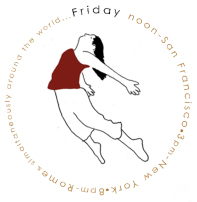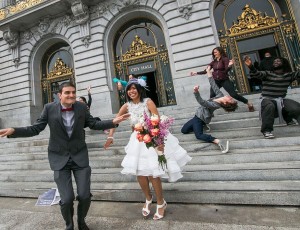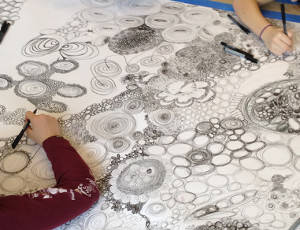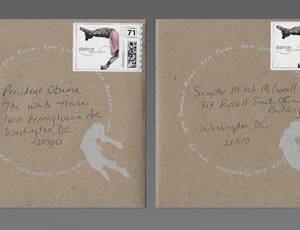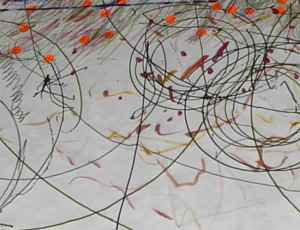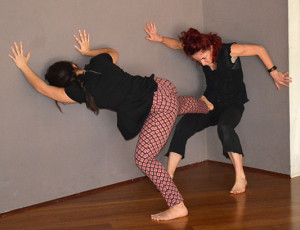In mid- June Amara Tabor-Smith and dancers enlivened the streets of San Francisco with He Moved Swiftly but Gently Down the Not too Crowded Street. Tabor-Smith’s traveling, site-specific performance celebrated the life and times of Ed Mock, an African American gay artist who died from AIDS in the 1980’s leaving a legacy of dance in the bodies and spirits of Amara and other Bay Area artists of her era. Over a span of five hours the piece wove through the streets, summoning the spirit of Ed, remembering what San Francisco was and celebrating the community that we share.
Following the performance Amara met with dance anywhere to discuss her process and post-show reflections. In this exclusive, edited, interview Amara Tabor- Smith and Natalie Marsh, of dance anywhere, discuss the challenges and possibility of site-specific work as well as the potential for such work to engage community.
NM: Can you describe your process of developing the piece? Did community engagement play a role in this process?
ATS:
I would say in terms of the creative process, most of my community engagement was centered on research. I spoke with people who had lived here in Ed’s time, who lived in San Francisco. One of the other things I did during the process was to hold two events- One event was called Carried in the Body: Dance Legacies Lost and Found. I had choreographers who had been working here for 20-some years talk about their legacy of dance…
I had limited resources in terms of research material. There were a few newspaper clips about him but a lot of were lost. So I thought, you have to think of the time and it wasn’t as common to record and save work because it was expensive. This idea of a little video camera that was portable didn’t exist at the time- It was a big deal to have your piece video-taped. So it got me thinking about the question, What are artists and what is the legacy they want to leave behind? Are they thinking about it? Are they thinking about the way their work is preserved? So that was the impetus for [Carried in the Body]. I wanted to hear more, especially from artists and anybody who had been making work for 20 plus years was around in those days when Ed was around. So this idea of dance legacy in the body became a source of inspiration in the work.
NM: What was the other event?
ATS: The other event was a workshop about queer identity, art and race. This was also inspired by Ed Mock because, as a black gay choreographer, the idea of how you identified yourself artistically, politically etc, at that time in the Bay Area- boxed you in. If you were a Jazz dancer you got Jazz funding. If you were queer- although there really wasn’t queer funding back then…. In those days it was starting to be recognized- “Oh this is a gay artist” if you were identifying openly in that way, and Ed was- but he didn’t want to be boxed in. For that reason he didn’t get funding that other people got, who were more identifiable from a funding perspective.
The workshop was looking at how artists think of themselves, and how artists of color identify themselves. If Ed had been a white man he would have had a different experience as an artist in San Francisco, and so I wanted artists to come together and talk about race. In the queer community these conversations are happening but I don’t know that they’re happening cross- culturally in the way that they could.
The two events [Carried in the Body and the queer identity workshop] were inspired by my creative process. I wanted to reach out to a large audience… I have a history now where I like to do community engaged events when I am in the creative process of making a piece because I feel like it informs the work and also brings the community into the process of me making the work. Sometimes they actually see some aspect of the work- not always. Sometimes it a way of bringing people together.
NM: How did you perceive that the audience and various onlookers integrated into the piece or influenced the piece during performance?
ATS: I think the site-specific nature of the piece leant itself to this type of integration. In the beginning we started with a séance out in the street and we started with the audience engaged in a call and response. Next, [the audience] walked through a moving installation of an artist, me, dressed in a way that they had to pass through. This was what I called “the veil”. I felt like I was being the spirit of the veil, and in order for the audience to proceed, they had to walk through the veil.
There were also several parts where we got the audience to sing in parts. Marvin K White, the poet lead a whole process in a restaurant where everyone went into the restaurant and ate. We had the restaurant serve certain items off the menu that everybody got a taste of. Then he led a whole writing process on landmarks talking about, what are the landmarks of life that help us find home? The audience then put this writing on stickers and placed the stickers on his body. There was this idea around how people engage with their landmarks and things they remember.
So, yes, there were several sections that were about community engagement- That engaged the audience with the sites.
NM: I’m interested in knowing more about how you chose the specific sites in relation to Ed, and then how you engaged with the site after that to develop choreography.
ATS: Most of the sites were chosen at least, half or more, were chosen because they were connected to Ed personally. One site was in front of the dance studio where I first began to study with him. And then there was a restaurant where the audience was outside and we danced inside and this was a restaurant where Ed ate frequently. Everybody there loved him and he never paid for a meal or a bottle of wine. So most of them were connected to him, personally.
And then other sites were chosen because they had a certain feel to them. There’s one site of 27th and Valencia that just had a certain…for me that site had a feeling of San Francisco that just no longer exists.
NM: Can you describe that feeling?
ATS: It was….like holding space for the ghosts of the past. The space is very classic in the sense that it’s a mixture of being the 40’s or 50’s but at the same time holding a spirit, a feeling. There are a lot of spaces now that are these cafes with concrete slabs. They are all made kind of the same way- even restaurants- a lot of metal and wood slat tables, very clean. There’s nothing about these places that’s stained. That place [27th and Valencia] has a lot of stains, the feeling of something that made its mark and left it there, which for me gives a place character.
So there are these places. Many of the sites have character, a few are in alleys. Just the nature of the alley- alleys are places that are slightly raw, and there’s a lot that goes on in alleys energetically that’s about personality and character- raw and messy, beautiful and ugly, scary, dangerous. Alleys hold a lot. Alleys are like composites of the multiplicity of energies that a city holds. They’ll have murals, they’ll smell like piss, they’ll have birds.
NM: How did you then choreograph for these places? What was your process?
ATS: When I chose sites…I did a number of thngs I chose sites, I had index cards, I made a list of sites and I tried to create a pathway. That pretty much came right away. I made a list of aspects of his life that I really wanted to capture. Not only his life, but also the city. Not only the city but aids.
It was a process of thinking about what spaces would contain certain ideas. One of the spaces I found, I had no idea what would go there, but because the space was so rich, when I went down into the basement, I was like, “Oh his life gets told here- literally”, because I saw it as a space that he would have loved had he been alive.
So that’s how it happened- It was little by little, and some places- I was like, “I don’t know what we’re going to do here, and it just came”.
NM: What was your journey like dancing during the piece?
ATS: For me, personally?
NM: Yes.
ATS: I felt like more than anything I was holding the spirit of the piece. I was being him. I was Ed, except for the very beginning when I was the spirit of the veil. In the beginning I was the spirit who gaurds the veil between the living and the dead. You couldn’t really see me [in this section], I think some people knew it was me but you couldn’t really see me.
What was it like?… I think the hardest part was that I didn’t really get to see anything, because of where I was strategically. The only part I saw was the club scene, the first part of it. So for me it was a wild ride…It was powerful for me, especially actually taking on this idea that I was going to be him. I still don’t think I’m able to process how deep that is for me. He was such an important man in my life, so, so, so important. He was like my father. And his death was a huge loss for me. So to then be him- There’s so many ways its so profound- I’m doing the piece this year and this year I am the same age he was when he died.
There are all of these ways that taking him on has a deeper meaning for me. It was a journey. It felt very magical- And to be around such amazing artists who were magical- just being magical people. I don’t know, it’s a difficult thing for me to articulate. It was profound.
NM: Any post-show reflections?
ATS: This piece was transformative for me. It changed me, and the other performers have said the same thing. And the connection we made is so deep, and beautiful and wild- It was a big transformation.
I think the thing that really stood out for me was that I felt like this piece was my initiation into elder-ship. I had never really seen myself as an elder before. As a young dancer coming up in his company I was the baby, I was his youngest dancer. And now I’m the same age he was- and he was such an elder to me. It was like- “Oh actually I’m an elder now”. To assume that- It was like, “this is where I am now”. Maybe people have seen me that way before, but I have never really seen myself that way. But now its like, “Oh now I’m an elder”. Now I’m really officially an elder.

 Sign In
Sign In